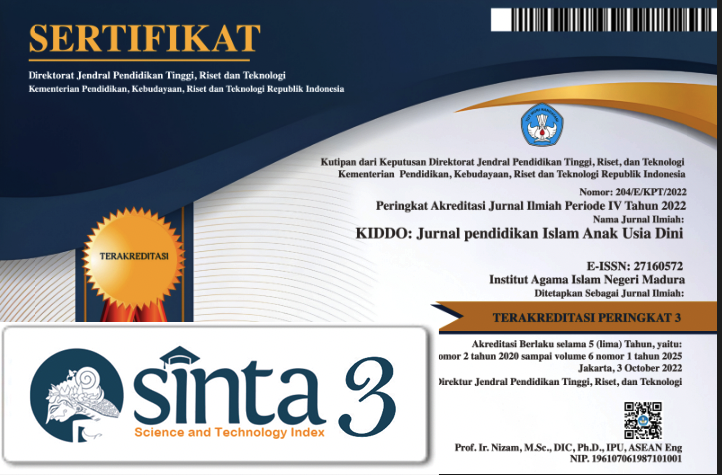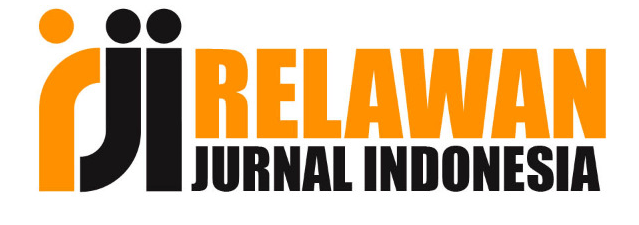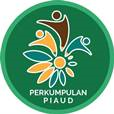Pengaruh Bermain Gymnastic Terhadap Kecerdasan Kinestetik Anak di Taman Kanak Kanak Harniatun Arrazzaq Bandar Lampung
 Abstract views: 244
,
Abstract views: 244
,
 PDF downloads: 157
PDF downloads: 157
Abstract
Lack of coordination of a person's movements is caused by the lack of optimal kinesthetic intelligence provided from an early age. This research is aimed at stimulating and developing children's kinesthetic intelligence. The type of research used is quantitative research with a Quasi Experimental research method and a Posttest Only Control Design design with the samples used, namely children in classes B1 and B2 consisting of experimental classes and control classes using purposive sampling techniques. The data collection techniques used are observation and documentation. The analysis technique for this research uses the SPPS version 26 for Windows program. Prerequisite test analysis was carried out to calculate normality using the Kolmogorov-Smirnov test, calculating homogeneity using the statistical Lavene test on both samples (Classes B1 and B2) and hypothesis testing analysis using the t test with the Independent sample T-test formula. Based on the results of calculations with the help of the SPPS program using a significance level of 5%, the hypothesis calculation results were obtained with a confidence level of 95%, tcount was 20.259, greater than ttable, namely 2.036 (20.259 > 2.036) with Sig. (2-tailed) of 0.000 where smaller than 0.05 (0.000 < 0.05) means that H0 is rejected and Ha is accepted. The conclusion is that there is an influence of playing gymnastics on children's kinesthetic intelligence at Harniatun Arrazzaq Kindergarten in Bandar Lampung.
Downloads
References
Amstrong, T. (2013). Kecerdasan Multiple di dalam Kelas. Indeks.
Ana Ainur Rohmah, J. (2020). Mengembangkan Kecerdasan Kinestetik Anak Usia Dini Melalui Pembelajaran Multiple Intelligences. PRESCHOOL: Jurnal Pendidikan Anak Usia Dini, Vol.1(No.1), 32–41. https://doi.org/https://doi.org/10.35719/preschool.v1i1.9
Aris Priyatno. (2014). Pengembangan kreativitas pada anak usia dini melalui bermain. Jurnal Ilmiah Guru “COPE”, No. 02/ Tahun XVIII/November 2014.
Australian Sports Commission. (2007). Gymnastics Companion Book. Australian Govemment.
Denok Dwi Anggraini. (2015). Peningkatan Kecerdasan Kinesetetik Melalui Kegiatan Bermain Sirkuit Dengan Bola (Penelitian Tindakan di Kelompok A TK Al Muhajirin Malang Jawa Timur). Jurnal PG - PAUD, Vol 2(No 1), hal 67.
Dina Adjei-Boadi, Samuel Agyei-Mensah, G. A. (2022). Neighbourhood, built environment and children’s outdoor play spaces in urban Ghana: Review of policies and challenges. Landscape and Urban Planning, 218. https://doi.org/https://doi.org/10.1016/j.landurbplan.2021.104288
Eliza Ayu Wardani. (2021). Meningkatkan Kecerdasan Kinestetik Melalui Games Ball di Kelompok Bermain. Journal On Teacher Education, Vo.3,No.2, 14–23.
Gardner, H. (1989). Theory of Multiple Intelligences. Educational Implications of the Theory of Multiple Intelligences, 18(8), 4–10. https://doi.org/10.3102/0013189X018008004
Gill, T. (2021). URBAN playground: How Child-Friendly Planning and Design Can Save Cities (1st ed). RIBA Publishing. https://doi.org/https://doi.org/10.4324/9781003108658
Gymnastics Canada Gymnastisque. (2008). Long Term Athlete Development: Gymnastics the Ultimate Human Movement Experience. Gymnastics Canada Gymnastisque.
Karin Lifter, Emanuel J.Mason, T. M. (2022). Emergent patterns in the development of young children’s object play. Acta Psychologica, 224. Karin LifterEmanuel J. MasonTakuya MinamiAmanda CannarellaRachel TennantAxline, 1947Piaget, 1962Vygotsky,1967Werner&Kaplan, 1963Bloom&Tinker, 2001McCune, 1995Hughes’(2012)Lifter&Bloom, 1989Hughes (2012)Herzberg et al., 2021Mandler (2004)Belsky&Most, 1981B
Lubis, Z. (2020). Hubungan antara Kecerdasan Kinestetik dengan Meniru Kegiatan Shalat Anak Usia 5-6 Tahun. Jurnal Raudhah, Vol.8(No.2), 58–67. http://jurnaltarbiyah.uinsu.ac.id/index.php/raudhah
Margono, Agus., dkk. (2009). Pendidikan Jasmani, Olahraga & Kesehatan. Panitia Sertifikat Guru Rayon 13.
Mayar, F. & Putri, Y. D. (2021). Kegiatan Senam Otak (Brain Gym) Dalam Meningkatkan Kecerdasan Kinestetik Anak Usia Dini. Vol.5(No.3), 9560–9563.
Mursid. (2015). Pengembangan Pembelajaran PAUD. PT. Remaja Rosdakarya.
Nanda Renza Farah Hasibuan. (2020). Pengaruh Kegiatan Senam Irama Terhadap Kecerdasan Kinestetik Pada Anak Kelompok B. Jurnal Pendidikan Anak, Vol.9(No.2), 118–123. https://journal.uny.ac.id/index.php/jpa
Oetari Sabrina Samahati. (2019). Upaya Meningkatkan Kecerdasan Kinesetetik Anak Usia Dini Melalui Permainan Lompat Tali Kelompok B di TK Nurul Hidayah. (Doctoral Dissertation, Universitas Islam Negeri Sumatera Utara).
Restu Yuningsih. (2015). Peningkatan Kecerdasan Kinestetik Melalui Pembelajaran Gerak Dasar Tari Minang (Penelitian Tindakan Kelompok B1 Di TK Negeri 01 Sungai Pagu Kabupaten Solok Selatan Tahun 2015). Jurnal Pendidikan Usia Dini, Vol. 9(No. 2), h. 235. https://doi.org/https://doi.org/10.21009/JPUD.092
Rita Sunoviani. (2020). Meningkatkan Kecerdasan Kinestetik Melalui Media Alat Musik Perkusi Pada Anak Kelompok B2 RA Babusalam.
Sri Widiyati, U. W. (2008). Mengoptimalkan 9 Zona Kecerdasan Majemuk Anak. Luna Publisher.
Sugiyono. (2017). Metode Penelitian Pendidikan. CV Alvabeta.
Suyati & Margono, A. (2000). Teori dan Praktek Senam. Departemen Pendidikan dan Kebudayaan Republik Indonesia Universitas Sebelas Maret.
Tadkiroatun Musfiroh. (2017). Pengembangan Kecerdasan Kinestetik Kecerdasan Majemuk. Universitas Terbuka.
TK Harniatun Arrazzaq. (n.d.). Dokumentasi Wawancara TK Harniatun Arrazzaq Bandar Lampung Tahun Ajaran 2021/2022.
Trajkovic, N. (2017). Impact of Gymnastic Program on Health-Related Fitness in Adolescent Pupils. Science of Gymnastics Journal, Vol.8(No.2), 157–166.
Copyright (c) 2024 Cahniyo Wijaya Kuswanto, Nilawati Tadjuddin, Silvi Indriani; Dona Dinda Pratiwi

This work is licensed under a Creative Commons Attribution 4.0 International License.
-
The journal operates an Open Access policy under a Creative Commons 4.0 International license. The terms of the license are:
Share— copy and redistribute the material in any medium or format
Adapt— remix, transform, and build upon the material for any purpose, even commercially.
1. Authors retain copyright and grant the journal right of first publication with the work simultaneously licensed under a Creative Commons License.that allows others to share the work with an acknowledgement of the work’s authorship and initial publication in this journal
2. Authors are permitted and encouraged to post their work online (e.g., in institutional repositories or on their website) prior to and during the submission process, as it can lead to productive exchanges, as well as earlier and greater citation of published work (See The Effect of Open Access).
Jurnal Kiddo is licensed under a Creative Commons
n Access).














